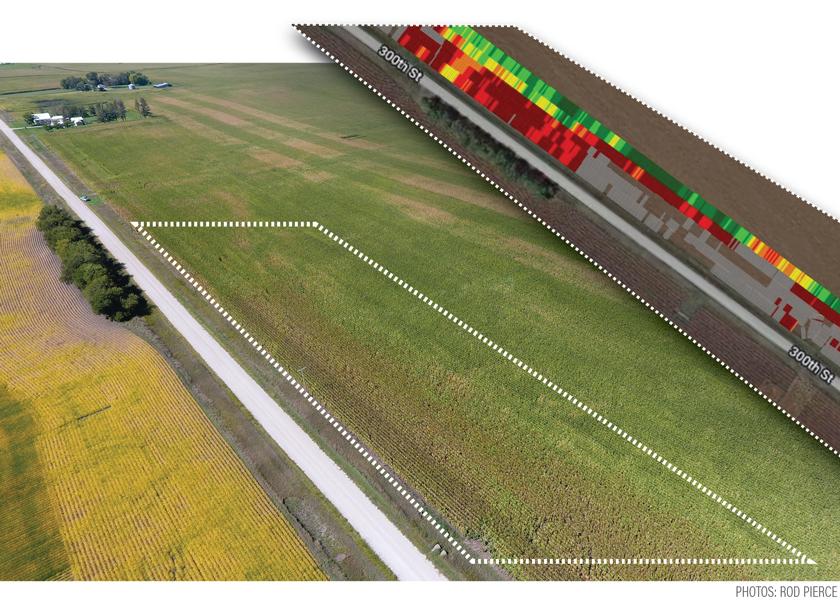Corn Yield Losses to ‘Edge Effect’ Elevated by Contrary Micro-Climate and Weather Patterns

Reasons for the so-called “edge effect” – unexplained yield losses in outer corn rows that disappear in interior rows – are coming into focus, thanks to work by Iowa State University Extension field agronomists.
Their work suggests edge effect is likely caused by a combination of corn micro-climate and adverse weather patterns, especially hot, dry, windy conditions in July and August, according to Mark Licht, ISU Extension cropping systems specialist.
Under those conditions, Licht says air passing over and mixing into the corn canopy is initially dryer at a field’s edge, causing corn respiration rates in outer rows of fields to be higher. Over time, that can lead to elevated drought stress along field edges.
Then, thanks to plant respiration, the air collects moisture as it passes further into the field which helps minimize or eliminate edge effect, and yield results become more normal.
Licht’s work in 2019 and again in 2020 suggests stress that occurs in summer during pollination and grain fill contribute primarily to yield loss from the edge effect. (For more information, see Licht’s ICM Blog on Edge Effect FAQs)
Yields Take Big Hit
Rod Pierce saw edge effect take a significant bite out of his corn yields this season.
“In one field, I had corn that yielded zero with the first pass of the combine,” says Pierce, who farms in Boone County.
 In another field, he recorded 150 bushels of corn with the first pass of the combine. Then, by the third pass of the combine, the yield monitor was showing 220 bushels per acre – a 70-bushel difference between the affected and unaffected corn.
In another field, he recorded 150 bushels of corn with the first pass of the combine. Then, by the third pass of the combine, the yield monitor was showing 220 bushels per acre – a 70-bushel difference between the affected and unaffected corn.
Pierce was one of several corn growers who told Meaghan Anderson, Iowa State University Extension (ISU) field agronomist, they were seeing the edge effect ding yield results this season.
“It’s been remarkably bad, worse this year than I have seen it in the past,” Anderson says. “It’s often three 12-row passes into a field before you start to see significant recovery of yield.”
While the issue seems to be concentrated in Iowa this season, Illinois farmers have also found the problem. Emerson Nafziger, professor emeritus at the University of Illinois, first reported on the issue in 2013
Contributing Factors Play A Role
Pierce says Licht’s explanation for edge effect makes sense, based on in-season NDVI data and drone pictures he’s reviewed with his consulting agronomist, Adam Walters, Premier Crop Systems, Huxley, Iowa.
Walters notes that in one of Pierce’s affected cornfields bordered by soybeans, a small stand of trees appears to have provided some buffer to dry, hot winds that swept across the field in late July and August. Walters took aerial photos with a drone, which shows how green the corn crop was early season, northeast of the trees. The two men evaluated the area again this fall via a yield map.
“The yield map shows a drastic line where the trees were and how that field yielded nearly zero bushels per acre to the east of that grove,” Walters says.
Pierce says he believe other factors, in addition to weather conditions, can compound edge effect. “A couple of years ago, some white gravel was put down on the road next to this field where we had the problem, and the dust from that gravel didn’t wash off the corn in those outer rows. I think that dust contributed to the problem, too,” he says.
Where To From Here?
The question now for many farmers is what agronomic practices to adopt for 2023. Anderson says there are at least two strategies farmers can consider – especially if they expect to be hit by hot, dry weather conditions again next season.
“One way to potentially manage this is to plant more stress-tolerant corn hybrids along field edges, particularly on the southern and western field edges where edge effect is typically the worst,” she says.
A second option is to consider reducing planting populations slightly in the outer rows of fields, which could reduce the competition between corn plants for water and nutrients.
Unfortunately, neither option is without some risk. “Of course, if we have a year without the edge effect, these strategies could reduce overall yield compared to our normal strategies,” Anderson says.
Regardless of what farmers who are experiencing edge effect opt to do next season, Anderson encourages them to investigate and discuss what they see in fields with their seedsman and agronomist and not rush to judgment on the cause.
“Edge effect doesn't happen every year, so it's this very challenging thing to even study, let alone try to scientifically research management strategies to use that are going to be effective to address it,” she says.
For his part, Pierce is still weighing his seed options and management decisions for 2023. “I’m researching it and talking to a lot of people,” he says. “I'm hoping this winter someone will come up with some ideas and show some data on something we can do proactively that would help, but right now, I don't have an answer for it.”
Ferrie: Do Fall Tillage if Fields are Dry, Consider No-Till Corn and Soybeans for 2023







